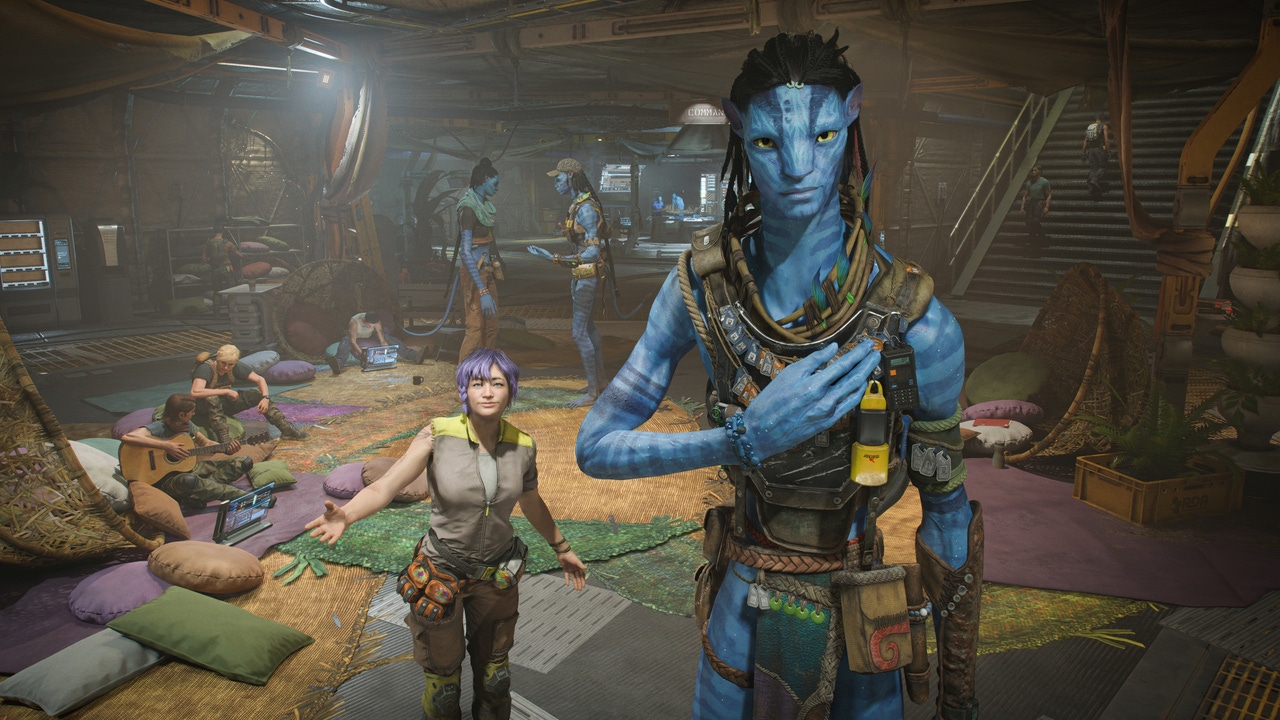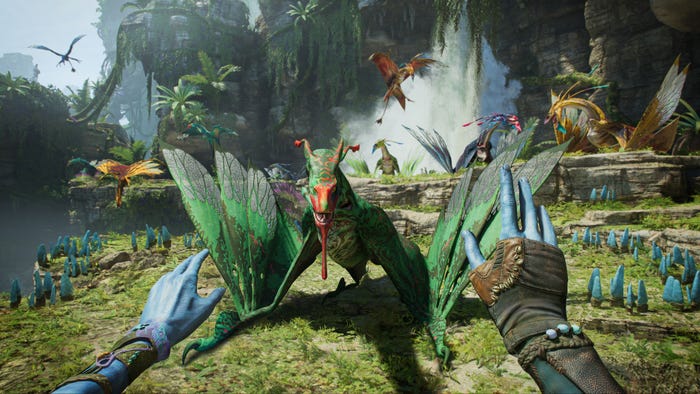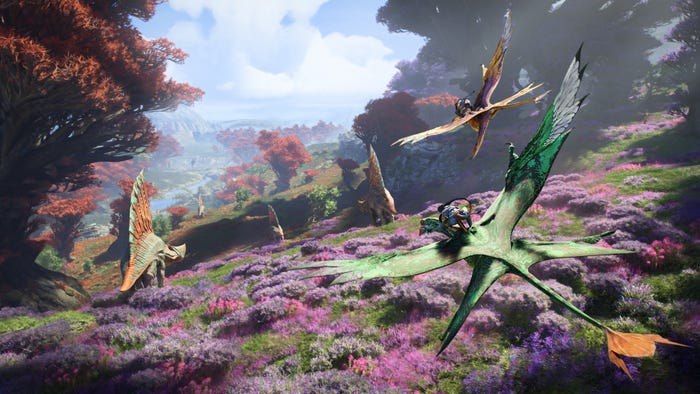Trending
Opinion: How will Project 2025 impact game developers?
The Heritage Foundation's manifesto for the possible next administration could do great harm to many, including large portions of the game development community.

One of the great successes of James Cameron's popular Avatar films is how they capture a lush, densely packed alien world full of natural wonders. With Ubisoft's second go at an Avatar title (following the 2009 game), the developers are focused on building an explorable corner of Pandora filled with unique sights and characters not shown in the movies.
With Avatar: Frontiers of Pandora, developer Massive Entertainment looks to capture Avatar's sense of wonder and scope, sure. The team is also diving further into that world by fleshing out the culture of the Na'vi tribes, the various animals and plants of Pandora, and giving players more of a reason to invest themselves in the setting. Speaking with game director Ditte Deenfeldt and senior narrative designer Chella Ramanan following extended hands-on time with the game, they told us about their larger goal of building an explorable Pandora, and how an open-world game felt like the right way to capture the setting's visually stunning—and equally hostile—world.
When it comes to open-world games, Ubisoft has built up an established framework for making them. Frontiers of Pandora takes particular cues from the Far Cry series—letting players loose into lush, vegetative lands filled with resources to find, animals to track and hunt, and enemy settlements to conquer. It's a well-known gameplay structure, but the new setting offers a compelling hook. It also proves to be an intriguing fit to engage with the thematic and world-building strengths of the franchise.
Frontiers of Pandora is set between the first two movies, focusing on the adventures of an orphaned Na'vi trained by the RDA corporation. After awakening from deep hibernation following the events of the first film, which saw them and their Na'vi brethren placed into hiding after the RDA sought to cut all ties with their trained Na'vi soldiers, the protagonist gets reacquainted with a changed Pandora. This leads to the game's core focus of exploring the western frontiers, filled with different Na'vi tribes in conflict and returning RDA colonizers seeking to take control.

While the Far Cry games leans into the high-octane take on the "fish-out-of-water" narrative, game director Ditte Deenfeldt jokingly referred to the main story and flow of Frontiers of Pandora about being a "fish in an artificial tank that's then placed into a beautiful tropical ocean."
There is truth to this, as the game is about a Na'vi character finally embracing his heritage and exploring the larger Pandora for the first time. This opens moments where you're exploring the world, engaging in quests to take down RDA strongholds and interacting with Pandora's "planimals"—the animate plants that you can interact with and use for traversal. The game's stand-alone concept, while still in keeping with the mythos of the films, was also a compelling angle for the devs at Massive Entertainment.
"We've worked closely together with [James Cameron's] Lightstorm Entertainment, and that means everything we're bringing to the table is canon," said game director Ditte Deenfeldt. "It means you're going into the real world of Avatar and experiencing it from a completely different angle and from a different side, meeting all new characters, different Na'vi clans and environments, and really allowing players to spend their time in the world as they wish. It's a brand new stand-alone story that just helps bring the world to life, and I think that's often what you want [for a video game adapting a film]. If you're excited by a world, and you want the opportunity to see more of it and see if from different sides—that's what we can offer."
To the devs, working on the Avatar game was an opportunity to create and add a new layer of detail to the world created for the films. One of these details relates to Na'vi tribe society, with players finally able to explore Na'vi towns, interact with other characters, and engage with the tribe's customs. For Massive Entertainment, Frontiers of Pandora was an opportunity to showcase Na'vi culture and the community in a more significant way. This was a particular highlight to senior narrative designer Chella Ramanan, who felt that Pandora and the characters therein outside of the main cast were worth exploring.
"With Avatar: Frontiers of Pandora, you can stay on Pandora for as long as you want, so we wanted to create that aspect where the player can go anywhere and there's adventure waiting for them," said Ramanan. "We've tried to make the world as rich as we coud—you can overhear conversations, you can meet other Na’vi and you really get that sense of life in a community carrying on regardless of you saving the world or saving the moon."
"Obviously, the cinematic universe was a starting off point for us, but we got to make all kinds of new aspects to the Avatar lore," she continued. "We have new creatures and new plants, and then we have these new clans in the new regions, and how that feeds into their culture because these are regions that are very distinct from each other and also distinct from the movies and the movie experience. So we were really about world-building within our area of Pandora. There are loads of great opportunities to look at how the different regions, the clans and their cultures can be expressed in the player experience."
During the extended demo, I explored the Kinglor Forest region of one of the game's first zones. This region was home to the Aranahe tribe, who live within the massive trees and worship silk-moth creatures that are vital to their community. This is a fairly common thing for games, but seeing the Na'vi and being able to sit in and observe their community really added an element of immersion, space and place that goes deeper than the films.

Frontiers of Pandora leans heavily into the mythology of the films, and many of the most memorable and visually distinctive elements from them are on full display in the game, such as the Tarzan-like traversal across the forests and landscapes of Pandora. So is the pro-environmental message underlying the fiction: the crucial importance of respecting nature and all those who reside in it. One of the most enjoyable moments came during the quest to find your Ikran, a Na'vi's flying mount. This brought many of the game's visuals and environmental storytelling elements together in a big way, entwining Na'vi culture and spectacle together.
It all works really well within the framework of an open-world game, and given that Avatar's main hook is about seeing a visually stunning—yet perilous—world in full display, the game offers an appealing way to experience James Cameron's sci-fi saga. With Frontiers of Pandora, Ubisoft and Massive Entertainment are especially eager to add a new layer to the Avatar series that will complement and elevate the world of the films going forward.
Read more about:
FeaturesYou May Also Like